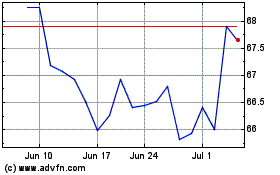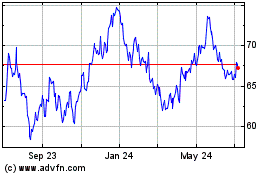Rio Tinto Underspends Already-Low Forecast
November 24 2016 - 12:20AM
Dow Jones News
Rio Tinto PLC, facing an uncertain market outlook, said it would
spend even less than anticipated on projects this year and step up
a productivity offensive.
Chief Executive Jean-Sé bastien Jacques said Thursday that while
he is cautiously optimistic on China—the world's top buyer of
commodities such as iron ore and copper—reforms there to reduce
capacity in industries such as coal and steel make the market less
predictable.
The world's No. 2 miner by market capitalization said project
spending in 2016 will be less than US$3.5 billion, down at least
13% from the previous forecast of around $4 billion—and a shadow of
the more than $17 billion it spent in 2012, as a decadelong
commodity-price boom turned bust. In the years since, mining
companies have slashed spending on projects and exploration.
Still, 2016 should be the low for Rio Tinto. It retained
forecasts of US$5 billion and US$5.5 billion for the coming two
years, respectively.
The company is an outlier among global miners in planning new
projects for the years ahead, hoping to be in pole position when
markets recover. It is advancing iron-ore and bauxite developments
in Australia and a copper mine in Mongolia.
Rio Tinto expects China to remain an engine of commodity demand
for years to come.
"Everything being equal, the underlying Chinese economy is going
well," said Mr. Jacques. "There is lots of cash put into the
economy."
Government industrial-reform plans could end up being good or
bad for steel-related commodities such as coal and iron ore, he
said. After Beijing placed restrictions on coal miners there in
April, prices for some types of coal more than tripled.
"We have been surprised by what the Chinese government did in
the coking-coal market. Nobody saw it," said Mr. Jacques. "The big
uncertainty we are facing today in relation to China is the pace of
restructuring of the state-owned enterprises."
Since the price surge, Chinese authorities have been relaxing
rules on miners to cool the market. Credit Suisse called the
restrictions "an embarrassing own-goal" for policy makers in a Nov.
21 note.
Rio Tinto reaffirmed plans to return 40% to 60% of underlying
earnings to shareholders over the long term as it doubles down on
productivity.
The miner said it expects in the next five years to generate $5
billion of additional free cash flow—a measure of cash generated
from operations minus investments—from a push to improve its
operations. It recorded $2 billion in free cash flow in the first
six months of this year.
Rio Tinto said the cash-flow drive was in addition to its effort
to cut costs by $2 billion across this year and next, which Mr.
Jacques said was on track. The company said it has been reducing
costs by running trucks harder and making processing plants more
efficient.
Speaking at an analyst briefing in Australia, Mr. Jacques
declined to comment in depth on a probe into payments associated
with a massive iron-ore deposit in Guinea called Simandou, which
this month triggered the firing of two top executives.
"Recent events related to Simandou have been very challenging,"
he said, adding that "we cannot say any more than our public
statements as it is now with the relevant authorities."
Write to Rhiannon Hoyle at rhiannon.hoyle@wsj.com
(END) Dow Jones Newswires
November 24, 2016 00:05 ET (05:05 GMT)
Copyright (c) 2016 Dow Jones & Company, Inc.
Rio Tinto (NYSE:RIO)
Historical Stock Chart
From Mar 2024 to Apr 2024

Rio Tinto (NYSE:RIO)
Historical Stock Chart
From Apr 2023 to Apr 2024
